Common menu bar links
Breadcrumb Trail
ARCHIVED - Infrastructure Canada - Report
 This page has been archived.
This page has been archived.
Archived Content
Information identified as archived on the Web is for reference, research or recordkeeping purposes. It has not been altered or updated after the date of archiving. Web pages that are archived on the Web are not subject to the Government of Canada Web Standards. As per the Communications Policy of the Government of Canada, you can request alternate formats on the "Contact Us" page.
Minister’s Message

Chuck Strahl
As Canada’s Minister of Transport, Infrastructure and Communities, I am pleased to present Infrastructure Canada’s Departmental Performance Report for 2009-2010. The report outlines the department’s accomplishments in providing financial support for public infrastructure that strengthens the country’s economy as we move towards a promising and prosperous future.
Canada’s Economic Action Plan provided a $62 billion boost to create jobs, to support workers, to build consumer confidence and to strengthen our economy. Our government’s commitment to protect Canadians from the worst effects of the global downturn, to create jobs and to strengthen Canada’s economy included unprecedented funding to provincial, territorial and municipal infrastructure projects. These investments in infrastructure, such as improved transit systems, water facilities, roads and highways and community centres, have benefited Canadians across the country by improving their quality of life, contributing to a cleaner environment and a stronger economy.
Under the Economic Action Plan (EAP), the department is responsible for delivering $5.5 billion in new, short-term funding to support construction-ready infrastructure projects. It has also accelerated existing programs under the Building Canada Plan to make funding available sooner. I am proud that we have successfully managed our programs and delivered stimulus funding faster than any previous federal infrastructure program. In fact, the department was awarded the APEX 2010 Award for Leadership in Service Innovation, for delivering the new $4 billion Infrastructure Stimulus Fund in record time, giving a green light for construction on thousands of projects which provinces, territories, municipalities and other partners were ready to build. Across all of its funds, Infrastructure Canada has now committed more than $10.2 billion towards over 6,100 infrastructure projects as part of Canada’s Economic Action Plan. When combined with the contributions of our funding partners, there is close to $30.5 billion committed to infrastructure projects across the country.
Infrastructure Canada’s accomplishments in the first year of the Government of Canada’s two-year Economic Action Plan are having a very real and positive impact, both on the economy and the environment. We have cut red tape and streamlined the approval process to speed up the start of necessary infrastructure projects. The economy is improving, more Canadians are working, and communities are benefitting from world-class, modern infrastructure. While recognizing that much has been achieved, much remains to be done. The department will continue to focus on delivering commitments made under Canada’s Economic Action Plan and will work with our provincial, territorial and municipal partners to ensure that stimulus projects are substantially completed by March 31, 2011.
As we reach the end of the government’s stimulus programs, we will continue to provide Canadians with quality, cost-effective public infrastructure that meets their needs in a competitive economy, a cleaner environment and liveable communities through long-term funding programs such as the Building Canada Plan, the Green Infrastructure Fund and the Gas Tax Fund. Through both targeted short-term investments and long-term stable funding, our infrastructure investments are providing enduring benefits for Canadians.
I invite you to follow our progress as we move forward in implementing our infrastructure goals, at http://www.creatingjobs.gc.ca.
The Honourable Chuck Strahl, P.C., M.P.
Minister of Transport, Infrastructure and Communities
Section I: Departmental Overview
1.1 Summary Information
1.1.1 Raison d’être
Strong, modern, world-class public infrastructure is a key factor in achieving the Government of Canada's priorities of a stronger economy, a cleaner environment and more prosperous, safer communities. Infrastructure Canada leads the Government of Canada’s efforts in addressing Canada’s public infrastructure challenges.
1.1.2 Responsibilities
I. Overview
Infrastructure Canada is responsible for federal efforts to enhance Canada’s public infrastructure through strategic investments, key partnerships, sound policies and practical research. The department ensures that Canadians benefit from world-class public infrastructure by supporting initiatives from coast to coast to coast. As a focal point for infrastructure issues and programs, the department is also a centre of expertise for federal infrastructure and a key funding partner for cities and communities across Canada.
The department has played a leading role in delivering Canada’s Economic Action Plan (EAP), rolling out an unprecedented amount of infrastructure investment in record time. We have developed and implemented $5.5 billion worth of new infrastructure funding programs for construction-ready projects, and accelerated funding under the government’s $33 billion Building Canada Plan (BCP) announced in Budget 2007.
II. Programs
Infrastructure Canada delivers a broad range of infrastructure programs, providing flexible and effective funding support to provincial, territorial, municipal and private sector infrastructure projects. The department’s funding activities include:
- The $33 billion programs under BCP announced in Budget 2007;
- The $5.5 billion in programs delivered by the department under the EAP; and
- Several previous programs currently winding down.
The following is a brief overview of Infrastructure Canada’s main programs as managed under the Building Canada Plan, Economic Action Plan, and Sunsetting and Other Programs.
| Building Canada Plan | ||
|---|---|---|
| Provincial-Territorial Infrastructure Base Fund (PT-Base Fund) | $2.3 Billion | Provides an annual amount ($25 million per year) to provinces and territories for infrastructure priorities identified in each jurisdiction’s Annual Capital Plan.The Fund was designed to help restore the fiscal balance, particularly in jurisdictions with smaller populations. Under the Economic Action Plan, jurisdictions could choose to accelerate all or part of the fund to be spent by March 31, 2011. ($495 million was accelerated). (2007-2008 to 2013-2014). |
| Gas Tax Fund (GTF) | $5 Billion from 2005 to 2010. ($2 Billion a Year from 2010-2011 to 2013-2014) | Through provincial and other agreements, this program activity provides municipalities with predictable, long-term funding coupled with local decision-making to enable them to build and rehabilitate public infrastructure that achieves environmental outcomes. (Started in 2005-2006, and in Budget 2008 the government announced that it intends to make this program ongoing). |
| Building Canada Fund-Communities Component (BCF-CC) | $1 Billion | Provides funding to address the unique infrastructure pressures facing smaller communities focusing on project investments in communities with populations of less than 100,000. The fund leverages additional contributions from other partners by limiting the maximum federal share for funded projects to normally one-third, with matching contributions from both the provincial and municipal level. (2008-2009 to 2016-2017). |
| Building Canada Fund-Major Infrastructure Component (BCF - MIC) | $6.7 Billion | Targets larger, strategic infrastructure projects of national and regional significance. At least two-thirds of the funding is targeted to national priorities of water, wastewater, public transit, the core national highway system and green energy. By providing up to 50% federal funding on a cost-shared basis, it leverages additional contributions from other partners to promote increased investment in strategic infrastructure. (2008-2009 to 2016-2017). |
| Economic Action Plan | ||
|---|---|---|
| Green Infrastructure Fund (GIF) | $1 Billion | Provides funding over five years for infrastructure projects that promote cleaner air, reduced greenhouse gas emissions and cleaner water. The Green Infrastructure Fund provides up to 50% of eligible project costs to promote increased investment in infrastructure investment in support of a more sustainable economy. (2009-2010 to 2013-2014). |
| Infrastructure Stimulus Fund (ISF) | $4 Billion | Is intended to accelerate and increase the number of provincial, territorial, municipal and some not-for-profit infrastructure projects. It focuses on the rehabilitation of existing assets and new infrastructure that are construction-ready and can be substantially completed by March 31, 2011. By providing up to 50% federal funding to projects, the Infrastructure Stimulus Fund leverages funding from other partners, generating a much greater overall effect to the Canadian economy through infrastructure spending. (2008-2009 to 2010-2011). |
| Building Canada Fund-Communities Component Top-Up (BCF-CC Top-Up) | $500 Million | Provides additional funding in the amount of $500 million (added to the Building Canada Fund-Communities Component) to fund additional two-year infrastructure projects in communities with populations of less than 100,000. All Building Canada Fund-Communities Component funding had to be committed in order to access Top-Up funding. (2008-2009 to 2010-2011). |
| National Trails Coalition | $25 Million | Through Infrastructure Canada’s National Recreational Trails program, funding is provided to the National Trails Coalition, who in turn provides funding to its partners to create, upgrade and sustain non-motorized, snowmobile and all-terrain-vehicle trails throughout the country.The government’s contribution is equally matched (50%) by the Coalition and its partners. (The program began in 2009-2010 and all funds were committed in this fiscal year period). |
| Sunsetting and Other Programs | ||
|---|---|---|
| Canada Strategic Infrastructure Fund (CSIF) | $4.9 Billion | Provides funding for projects in areas that are vital to sustaining economic growth and enhancing the quality of life of Canadians. The Canada Strategic Infrastructure Fund leverages additional contributions from other partners by providing up to 50% funding for eligible projects. (2003-2004 to 2012-2013). |
| Municipal Rural Infrastructure Fund (MRIF) | $1.1 Billion | Provides funding for small-scale municipal infrastructure projects designed to promote and improve quality of life in both urban and rural communities. For most projects, the MRIF provides up to one-third federal funding for eligible projects. (2003-2004 to 2012-2013). |
| Border Infrastructure Fund (BIF) | $675 Million | Provides funding for investments in physical infrastructure, transportation system infrastructure and improved analytical capacity at surface border crossings. The fund provides up to 50% federal funding. (2003-2004 to 2012-2013). |
| Infrastructure Canada Program | $2.05 Billion | This program, which sunsetted in 2009-2010, was designed to enhance infrastructure in Canada’s urban and rural communities and to improve the quality of life through investments that protected the environment and supported long-term community and economic growth. Funding has been approved for over 3,700 projects since the fund’s inception in 2000-2001. (2000-2001 to 2009-2010). |
| Support for the G8 Summit (2010) | $50 Million | Provided funding for infrastructure projects that supported the hosting of the G8 Summit in June 2010 in Huntsville, Ontario, and provided a legacy to local communities and the region as a result of hosting the Summit. (2009-2010 to 2010-2011). |
Federal Delivery Partners
As the lead federal department responsible for infrastructure policy development and program delivery, Infrastructure Canada collaborates with other federal departments and agencies. The department’s Federal Delivery Partners (FDPs) are: Transport Canada, Indian and Northern Affairs Canada, Industry Canada, Western Economic Diversification, Canada Economic Development for Quebec Regions, and the Atlantic Canada Opportunities Agency.
These departments and agencies share their knowledge of local needs and priorities, as well as their technical expertise, resources and governance structures and are critical to Infrastructure Canada in fulfilling its mandate.
PROJECT SPOTLIGHT
Reduced Operating Costs: Enhanced Recycling, More Jobs
Saint John, New Brunswick
 |
A $220,477 contribution from the Communities Component of the federal Building Canada Fund has improved the recycling process in Saint John, reducing the volume of recyclable materials ending up in landfills. The Fundy Region Solid Waste Commission used the funds to build a sorting conveyor that facilitates the separation of recyclables, and to buy new baling equipment that packages the sorted materials on-site for direct shipment to buyers. |
1.1.3 Strategic Outcome and Program Activity Architecture (PAA)
In accordance with the Treasury Board’s Management, Resources and Results Structure Policy, Infrastructure Canada’s Program Activity Architecture (PAA) structure provides a framework for all departmental activities. It organizes resource allocation (both human and financial) against activities and expected outcomes, and provides a meaningful way to link activities to broader Government of Canada Outcomes.
Infrastructure Canada’s PAA structure continues to evolve as priorities change, the department is given more responsibilities, and the number of programs increases. In late 2009, the department’s Strategic Outcomes and PAA structure were amended to reflect its activities and new responsibilities. The new structure is detailed in Figure 1, under the following three strategic outcomes:
- Provinces, territories and municipalities have federal financial support for their infrastructure priorities: Provides federal transfers to provincial, territorial and municipal governments for their local infrastructure priorities and to help maintain a level of core infrastructure across the country.
- Funding for quality, cost-effective public infrastructure that meets the needs of Canadians in a competitive economy, a cleaner environment and liveable communities is provided: Provides targeted project-specific investments to address federal/provincial priorities in smaller communities as well as large strategic investments of national and regional benefit.
- Construction-ready infrastructure projects are provided with federal funding support: Provides timely, temporary and targeted funding to construction-ready projects to support short-term economic stimulating over a two-year period to March 31, 2011 under the Economic Action Plan.
The strategic outcomes highlight three major activity areas of the department. They speak to the long-term benefits of our infrastructure investments under programs such as the Building Canada Plan, and of our more temporary activities – such as the significant funding being provided under the Economic Action Plan.
This document reports on the basis of the latest approved PAA, as reflected in the 2010-2011 Report on Plans and Priorities, in order to adequately report on the EAP programs of 2009-2010. Each program activity is discussed in detail in Section II of this report.
Figure 1: Program Activity Architecture

| * |
This is a temporary strategic outcome to accommodate short-term measures including the Economic Action Plan initiatives assigned to Infrastructure Canada. Funding in support of the G8 Summit and for the National Trails Coalition was provided in 2009-2010. |
| ** |
These funds are not part of the Economic Action Plan. |
|
Additional note: An additional program activity, Internal Services, is not reflected in this chart. |
Acronymns
BCF-CC – Building Canada Fund-Communities Component
BCF-MIC – Building Canada Fund-Major Infrastructure Component
GIF – Green Infrastructure Fund
CSIF – Canada Strategic Infrastructure Fund
MRIF – Municipal Rural Infrastructure Fund
BIF – Border Infrastructure Fund
EAR – Economic Analysis and Research
ISF – Infrastructure Stimulus Fund
BCF-CC – Top-Up – Building Canada Fund-Communities Component Top-Up
1.1.4 Program Activity Architecture Crosswalk
Until 2009-2010, Infrastructure Canada had one strategic outcome: “Quality, cost-effective public infrastructure that meets the needs of Canadians in a competitive economy, a clean environment and liveable communities”, and five program activities:
- Targeted Provincial Project-Based Infrastructure Funding;
- Provincial-Territorial Infrastructure Base Fund;
- Gas Tax Fund;
- Knowledge and Research; and
- Internal Services.
Under the new PAA adopted in late 2009, the Targeted Project-based Infrastructure Funding program activity was dropped, and the five funding programs which were previously under that activity became program activities in their own right.
In fact, each of the department’s 12 major funding programs are now individual program activities. Knowledge and Research (now called Economic Analysis and Research) and Internal Services remain as program activities.
The new PAA organizes program activities under three strategic objectives (see Figure 1).Funding, human resources and performance indicators are organized against the 14 activities. This amendment to the program activity architecture structure is reflected in the 2010-2011 Report on Plans and Priorities. Each program activity is discussed in detail in Section II of this report.
1.2 Summary of Performance
2009-2010 was the most challenging and successful year in Infrastructure Canada’s short history. Faced with the worst economic recession since the 1930s, the Government introduced the Economic Action Plan (EAP) in Budget 2009 to quickly turn the economy around and create jobs.With stimulus spending on infrastructure as a key part of the EAP package, the department had to work quickly to respond to the challenge.
In just two months after Budget 2009 was introduced in January 2009, new infrastructure programs such as the Infrastructure Stimulus Fund had been developed, approved and launched. We also worked to accelerate funding and project approvals for already-existing infrastructure programs under our existing Building Canada Plan. Key to our efforts in developing our new programs was creating streamlined on-line application and approval processes to make it easier and faster for project proponents to apply for funding, and for the department to review applications.
In the early part of fiscal year 2009-2010, Infrastructure Canada continued to move very quickly, negotiating and signing funding agreements with all provinces and territories. We received and reviewed thousands of project applications from municipalities, provinces/territories and other project proponents under the Infrastructure Stimulus Fund and the Building Canada-Communities Component Top-Up alone. We committed close to $10.2 billion in funding to more than 6,100 projects across Canada. That $10.2 billion committed is leveraging significant funding from partners, providing an incredible $30.5 billion in overall infrastructure investment. Infrastructure Canada delivered in record time – program design and implementation, project applications and approvals, and funding commitments were done in a matter of months, a process that in the past has taken several years.
Today, there is work underway in every province and territory – everything from road work and bridges to water works, libraries and recreation centres. (The Project Spotlights throughout Section I of this report give examples of these projects). Close to 4,200 projects are underway as of August 2010, worth a total of $20 billion in total investment. People are working, and communities are receiving vital infrastructure.
As the department moves into the 2010-2011 fiscal year, we have shifted our focus from committing EAP funding to ensuring that projects are completed, financial claims from proponents are processed quickly and efficiently, and Canadians and communities are receiving short- and long-term value from our investments.
PROJECT SPOTLIGHT
New, Safe Water Supply
Lorette, Manitoba
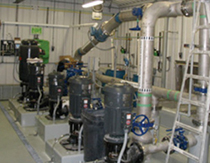 |
With the help of $600,000 from the Communities Component of the Building Canada Fund, the community of Lorette, Manitoba got a new water supply well, a one-million-litre concrete reservoir, and a pumping station with filtration and disinfection capacity. The project eliminated potable water contamination in Lorette's municipal system and extends service to more of the town's 2,100 residents. |
1.2.1 Financial and Human Resources
Infrastructure Canada’s financial and human resources information over the reporting period are summarized in the two tables that follow.
Table 1: 2009-2010 Total Financial Resources
| Planned Spending | Total Authorities1 | Actual Spending |
|---|---|---|
| 7,134,885 | 5,470,649 | 4,218,060 |
Table 2: 2009-2010 Total Human Resources
| Planned | Actual2 | Difference |
|---|---|---|
| 256 | 298 | 42 |
For comparison purposes, the financial and human resources information for 2008-2009 is presented in the tables below:
Table 3: 2008-2009 Total Financial Resources
| Planned Spending | Total Authorities | Actual Spending |
|---|---|---|
| 2,910,254 | 3,350,720 | 2,279,846 |
Table 4: 2008-2009 Total Human Resources
| Planned | Actual | Difference |
|---|---|---|
| 257 | 231 | (26) |
As a small department, Infrastructure Canada's employees work on multiple programs and are not permanently linked to any specific program. This flexibility has allowed the department to re-allocate individuals and use resources on more than one single funding program. This has been one of its key success factors in moving quickly to develop, implement and manage the new programs under the EAP. For the purposes of this document, where applicable and appropriate, FTEs and actual spending are aligned with specific programs, as delivered in 2009-2010.
1.2.2 Program Activities by Strategic Outcome and Actual Spending
Table 5 summarizes the achieved results of the 14 main program activities, the actual spending under each activity, as well as the alignment of these activities to the Government of Canada outcomes. The overall expected results for these program activities are improved and increased stock of core public infrastructure and improved quality of life and economic opportunities for Canadians. Internal Services is also in this table, which underpins and supports the entire department in meeting Government of Canada outcomes.
Table 5: Performance Summary
| Strategic Outcome 1: Provinces, territories and municipalities have federal financial support for their infrastructure priorities. | ||||||
|---|---|---|---|---|---|---|
| Performance Indicators | Results | 2009-2010 Performance | ||||
| The number of agreements signed between the department and its partners, the number of initiatives approved, amount of federal funding committed, and funding leveraged from its partners and stakeholders. |
As part of the EAP, the department accelerated funding under the Provincial-Territorial Infrastructure Base Fund in eight provinces and territories. We signed eight contribution agreements, approved plans with 318 initiatives, and committed $1.1 billion in funding which leveraged an additional $1.6 billion in overall investment. In 2009-2010 Infrastructure Canada transferred $1.8 billion in Gas Tax Fund money to over 3,600 Canadian municipalities. |
Faced with the enormous challenge of delivering infrastructure investments under the EAP in record time, the department successfully accelerated funding under the P/T Base Fund to those provinces and territories who opted for it. The department also continued to successfully implement the Gas Tax Fund, signing amendments to agreements to extend funding until 2014. |
||||
| Program Activity | 2008-2009 Actual Spending | 2009-20103 | Alignment to Government of Canada Outcomes4 | |||
|---|---|---|---|---|---|---|
| Main Estimates | Planned Spending | Total Authorities | Actual Spending | |||
| Provincial-Territorial Infrastructure Base Fund | 390,602 | 329,131 | 824,131 | 771,831 | 672,032 | Strong Economic Growth |
| Gas Tax Fund | 986,006 | 1,976,488 | 1,976,488 | 1,974,980 | 1,873,874 | Strong Economic Growth |
| Sub-Total: | 1,376,608 | 2,305,619 | 2,800,619 | 2,746,811 | 2,545,906 | |
| Strategic Outcome 2: Funding for quality, cost-effective public infrastructure that meets the needs of Canadians in a competitive economy, a cleaner environment and liveable communities is provided. | ||||||
|---|---|---|---|---|---|---|
| Performance Indicators | Results | 2009-2010 Performance | ||||
| The number of agreements signed between the department and its partners, the number of projects approved by the department, amount of federal funding committed by the department, and dollars leveraged from its partners and stakeholders. |
As part of the EAP, the department significantly accelerated funding under several programs, including the Building Canada Plan-Major Infrastructure Component. The Community Component was also accelerated, and fully committed in all provinces. Overall, for all of the programs under this strategic outcome, the department has committed $8.6 billion in funding to nearly 3,100 projects worth $43.3 billion. Section II provides greater details of each individual program. |
By working with partners to effectively and efficiently accelerate funding and approve projects, Infrastructure Canada is delivering on its significant EAP commitments. It has approved projects and committed an unprecedented amount of funding in record time. |
||||
| Program Activity | 2008-2009 Actual Spending | 2009-20105 | Alignment to Government of Canada Outcomes6 | |||
|---|---|---|---|---|---|---|
| Main Estimates | Planned Spending | Total Authorities | Actual Spending | |||
| Building Canada Fund-Communities Component | 808 | 117,500 | 117,500 | 207,935 | 101,065 | Strong Economic Growth |
| Building Canada Fund-Major Infrastructure Component | 55,425 | 674,257 | 665,090 | 594,969 | 196,876 | Strong Economic Growth |
| Green Infrastructure Fund7 | See Footnote 7 | See Footnote 7 | 200,000 | 5,160 | 5,760 | Clean and Healthy Environment |
| Canada Strategic Infrastructure Fund | 505,429 | 484,239 | 513,410 | 648,876 | 420,202 | Strong Economic Growth |
| Municipal Rural Infrastructure Fund | 220,324 | 483,763 | 483,763 | 483,763 | 221,766 | Strong Economic Growth |
| Border Infrastructure Fund | 81,111 | 66,715 | 66,715 | 99,987 | 80,863 | Strong Economic Growth |
| Economic Analysis and Research | 1,747 | 10,398 | 19,565 | 10,609 | 4,142 | Innovative and Knowledge-Based Economy |
| Internal Services | 38,394 | 18,223 | 18,223 | 70,765 | 51,837 | |
| Sub-Total: | 903,238 | 1,855,095 | 2,084,266 | 2,122,064 | 1,082,511 | |
| Strategic Outcome 3: Construction-ready infrastructure projects are provided with federal funding support. | ||||||
|---|---|---|---|---|---|---|
| Performance Indicators | Results | 2009-2010 Performance | ||||
|
The number of agreements signed between the department and its partners, the number of projects approved by the department, amount of federal funding committed by the department, and dollars leveraged from its partners and stakeholders. |
Under this strategic outcome, Infrastructure Canada launched new funding programs coming out of the EAP, and fully committed all funding. Overall, since the inception of all of the programs under this strategic outcome, the department has committed more than $4.5 billion in funding to more than 5,000 projects worth $10.1 billion. Section I provides greater details of each individual program. Through its efforts, Infrastructure Canada is providing short-term economic stimulus, timely and temporary funds for construction-ready projects to support short-term economic stimulus. |
Working with provinces, territories, municipalities and other partners, Infrastructure Canada moved from new program design to project approvals and funding commitments in a matter of months. |
||||
| Program Activity | 2008-2009 Actual Spending | 2009-20108 | Alignment to Government of Canada Outcomes9 | |||
|---|---|---|---|---|---|---|
| Main Estimates | Planned Spending | Total Authorities | Actual Spending | |||
| Infrastructure Stimulus Fund10 | See Footnote 10 | See Footnote 10 | 2,000,000 | 496,729 | 493,129 | Strong Economic Growth |
| Building Canada Fund-Communities Component Top-Up10 | See Footnote 10 | See Footnote 10 | 250,000 | 30,045 | 30,745 | Strong Economic Growth |
| Support for the G8 Summit (2010)11 | See Footnote 11 | See Footnote 11 | See Footnote 11 | 50,000 | 40,669 | Strong Economic Growth |
| National Trails Coalition11 | See Footnote 11 | See Footnote 11 | See Footnote 11 | 25,000 | 25,100 | Strong Economic Growth |
| Sub-Total: | 2,250,000 | 601,774 | 589,643 | |||
| Total Actual Spending: | 2,279,846 | 4,160,714 | 7,134,885 | 5,470,649 | 4,218,060 | |
PROJECT SPOTLIGHT
Preserving Inuit Culture in Nunavut: Piqqusilirvvik (Inuit Cultural Learning Facility)
Clyde River, Nunavut
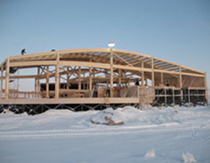 |
With $182.68 million from the Provincial-Territorial Base Fund, Nunavut is undertaking several initiatives, including building a new Inuit cultural learning centre on the northeast coast of Baffin Island. The centre will be used as a school, as well as a learning centre for elders to help young people maintain their cultural values. The facility will help protect Inuit culture and history and will play a vital role in the promotion and preservation of Inuit culture, language and heritage for future generations. |
1.3 Contribution of Priorities to Strategic Outcomes
Infrastructure Canada’s priorities for 2009-2010 included one operational priority and two management priorities that were either ongoing or previous commitments:
Operational Priority
- To expedite investments in provincial, territorial and municipal infrastructure projects.
Management Priorities
- To respond to opportunities for improvement identified in the Management Accountability Framework (MAF) assessments of 2008; and
- To support Public Service Renewal and improve People Management.
Table 6: Contribution of Priorities to Strategic Outcome
| Operational Priorities | Type12 | Status | Linkages to Strategic Outcome (s) |
|---|---|---|---|
| 1. To expedite investments in provincial, territorial and municipal infrastructure projects. | New | In 2009-2010 Infrastructure Canada launched new programs under EAP, and accelerated funding under existing programs. The department negotiated and signed agreements with all provinces and territories, and approved and committed close to $10.2 billion to over 6,100 projects. This is leveraging total infrastructure investments of close to $30.5 billion nationally. We successfully delivered year one of EAP in record time. | Strategic Outcome 1 |
| Management Priorities | Type12 | Status | Linkages to Strategic Outcome (s) |
|---|---|---|---|
| 1. To respond to opportunities for improvement of the Management Accountability Framework (MAF) assessment of 2008. | New |
Infrastructure Canada’s 2009-2010 MAF assessment was generally positive, with improved ratings in some key areas. For example, the department strengthened its internal audit and evaluation functions, allowing it to better assess the relevance, success and cost-effectiveness of its programs. The department is currently developing measures to maintain our positive ratings, and to address areas needing improvement. |
Strategic Outcome 1 |
| 2. To support Public Service Renewal and improve People Management. | Ongoing | In 2009-2010 Infrastructure Canada developed and implemented a Vision for People Management, and revised the Integrated Business and Human Resources Plan (IBHRP) to incorporate this vision into action planning, and to develop measurable indicators. The People Management Committee is monitoring implementation of the plan via monthly meetings and quarterly statistics. As a result, the department has improved on its recruitment and retention targets, and made significant progress in addressing the priorities set out in the Public Service Renewal Action Plan. | Strategic Outcome 1 |
PROJECT SPOTLIGHT
Desjardins Drinking Water Treatment Facility
Lévis, Quebec
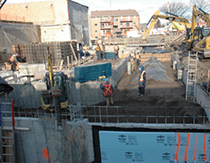 |
With almost $10.8 million from the federal Building Canada Fund, the upgrades to the Desjardins Drinking Water Treatment Facility will support growing community, industrial and commercial demands for reliable, potable water in Lévis, Quebec. By adding filters and an ultraviolet disinfection system, and completing building repairs, the facility will almost triple its production capacity – meeting the water needs of the area for the next 30 years. |
1.4 Risk Analysis
1.4.1 Risk Analysis Approach
Infrastructure Canada applies a comprehensive approach to actively identify, assess, and manage risks at four distinct levels: Strategic, operations, program and project. The department conducts regular environmental scans to identify internal and external risk factors. These risks are then analyzed to determine probability and potential impact, and mitigation strategies are developed. All of this is captured in the department’s Corporate Risk Profile and semi-annual Report on Risk Responses and Re-Assessment of Critical Risk Placements. The department also performs specific risk analyses for its large programs, such as the Infrastructure Stimulus Fund and the Building Canada-Major Infrastructure Component.
1.4.2 Changing Economic Conditions and Government-Wide Priorities
Within the last few years, the Canadian economy has faced extraordinary challenges. The government’s Economic Action Plan committed $12 billion to infrastructure improvements to help stimulate the economy. Following the meeting of First Ministers in January 2009, Infrastructure Canada moved quickly to reduce duplication and streamline federal processes to accelerate federal infrastructure funding. It committed funding to thousands of projects through new programs – and accelerated funding under existing ones – in partnership with provincial, territorial and municipal governments. This included identifying projects in each jurisdiction that could be completed by March 31, 2011.
Under the EAP, the Government of Canada launched a national partnership with provinces, territories and municipalities, who provided matching funding for projects, and identified projects that could be tracked and substantially completed by March 31, 2011.
For its part, Infrastructure Canada streamlined its project review and approval process and the government approved new regulations to accelerate environmental approvals while protecting the environment. As a result, Infrastructure Canada launched programs and approved projects in record time, allowing partners, who manage construction, to proceed quickly.
1.4.3 Key Critical Risks
Human Resources Capacity and Capability
The 2009 Corporate Risk Profile identified human resources challenges as the most significant risk to the department’s ability to deliver on its mandate. In addressing this risk, the department worked to complete its Integrated Business and Human Resources Plan, recruit skilled individuals and decrease the staff turnover rate. This included aggressively putting in place staffing strategies, conducting orientation sessions for its new employees, and developing business models and work tools to support employees. Because of these efforts, this risk has moved from an “Acceptable Risk” to a “Manageable Risk” in the Corporate Risk Profile.
1.4.4 Oversight of Infrastructure Projects
Fast-tracking thousands of project approvals and accelerating infrastructure funding in partnership with provincial, territorial and municipal governments presented an important challenge in ensuring oversight of projects. This challenge was assessed as the second highest risk to Infrastructure Canada’s achievement of its mandate. But thanks to risk responses such as establishing accountability mechanisms, creating oversight and management committees, and more rigorous project application and reporting systems, the likelihood and potential impact of this risk has been reduced.
PROJECT SPOTLIGHT
Working Together: Improving Public Safety
Pouce Coupe, British Columbia
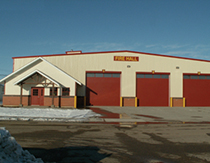 |
With $200,000 in federal assistance from the Infrastructure Stimulus Fund, Pouce Coupe, a village in British Columbia’s Peace River Valley, built and opened a new fire hall in 2009. It now houses the village's two pumpers and one tanker, and provides training facilities for volunteers, helping give Pouce Coupe a modern, up-to-date fire department. |
1.5 Expenditure Profile
1.5.1 Spending Trends
Infrastructure Canada’s spending has increased significantly as the department continues to implement the new programs under the Economic Action Plan (EAP) and its existing programs. Figure 2 represents the department’s forecast and actual spending profile from 2005-2006 to 2009-2010. From 2005-2006 to 2007-2008, total spending included all Parliamentary appropriation sources: Main Estimates, Supplementary Estimates, Treasury Board Votes 10, 15 and 22, as well as carry-forward adjustments. Spending up to 2009-2010 corresponds to previously planned, plus spending related to new infrastructure funds announced in Budget 2009. Spending related to the EAP started in 2009-2010, and is planned to continue until 2011-2012 (except for the Green Infrastructure Fund, which is planned to continue until 2013-2014).
Figure 2: Departmental Spending Trend and the Economic Action Plan (EAP)
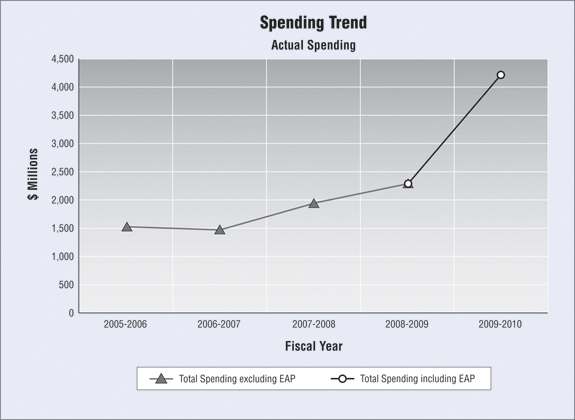
In 2009-2010, Infrastructure Canada spent a record $4.2 billion on infrastructure investments under new and sunsetting programs. The department’s spending increased by 85% over 2008-2009, which was also a record year.
Statutory funding authority for the programs under the Economic Action Plan was provided in the Budget Implementation Act. These programs are: The Infrastructure Stimulus Fund, the accelerated funding under the Provincial-Territorial Infrastructure Base Fund, the Green Infrastructure Fund and the Building Canada Fund-Communities Component Top-Up, all of which are expected to be completed by March 31, 2011.
1.5.2 Variations in Program Spending Trends
In 2009-2010, Infrastructure Canada flowed a record amount of funding to provinces, territories, municipalities and non-governmental organizations to support public infrastructure projects. Through a suite of transfer payment programs, the department supports quality, cost-effective public infrastructure investments across Canada.
Program design recognizes the provincial, territorial and municipal responsibility for a majority of public infrastructure, and Infrastructure Canada's participation as a funding partner. The department is not responsible for the management of infrastructure projects, but rather for the reimbursement of eligible expenses submitted by recipient project managers (for contributions programs), or in the case of other transfer payment programs, it provides stable base funding to provinces, territories and municipalities under the terms of signed agreements.
It is important to note that the department’s cash flow lags behind the actual rate of construction of projects, and is not a good indicator of economic activity. Work begins upon project approval: contracts are put in place, plans drawn up, materials are ordered and construction starts. While the department commits funds immediately upon approval, federal funding only flows to recipients to reimburse actual costs incurred as construction proceeds. In many cases, recipients wait until completion of the project before submitting a claim. Upon receiving completed claims, the department pays in 30 days.
We continually work with our partners to ensure our forecasts are as accurate as possible, and to reprofile Infrastructure Canada’s funding to meet the needs of our partners.
As such, the $1.2 billion of unspent 2009-2010 authorities has been re-profiled to future years to better match the needs of our partners.
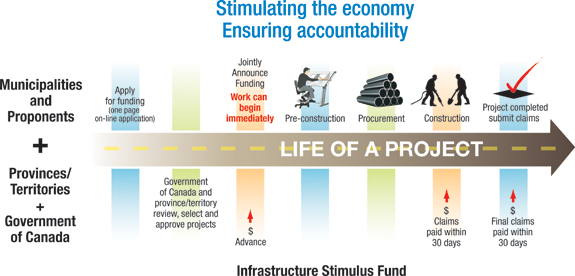
1.5.3 Voted and Statutory Items
Table 7: Voted and Statutory Items Listed in Main Estimates
| Vote # or Statutory Item (s) | Truncated Vote or Statutory Wording | 2007-2008 Actual Spending | 2008-2009 Actual Spending | 2009-2010 Main Estimates | 2009-2010 Actual Spending |
|---|---|---|---|---|---|
| 50 | Operating expenditures | 35,177 | 36,637 | 40,283 | 59,391 |
| 55 | Contributions | 1,917,009 | 2,240,257 | 4,117,074 | 3,448,906 |
| (S) | Contributions13 | – | – | – | 705,317 |
| (S) | Contributions to employee benefit plans | 2,582 | 2,952 | 3,357 | 4,446 |
| Total | 1,954,768 | 2,279,846 | 4,160,714 | 4,218,060 | |
In 2009-2010, Infrastructure Canada spent a record of over $4.2–billion on infrastructure investments under new and sunsetting programs to meet the expected results of its program activities and contribute to its strategic outcomes. This represents an increase of $1.9–billion over the previous year. This was primarily due to new funding received for the Building Canada Fund (BCF), the doubling of the Gas Tax Fund (GTF), as well as the new programs introduced by the Economic Action Plan (EAP) in Budget 2009.
The Main Estimates can be accessed at: http://www.tbs-sct.gc.ca/est-pre/20092010/p2-eng.asp.
